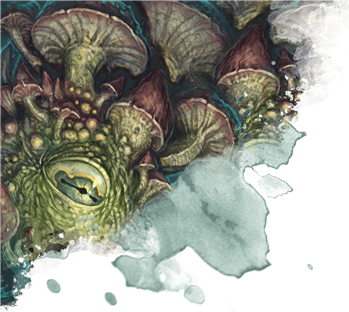 This week’s encounter is a short scare that you can insert into your campaign while the characters are wandering a spooky, marshy landscape. In other words, it is Mystery of the Myconid Mausoleum, a short combat encounter with three parts: a discovery, a combat, and a reveal. Together, these three principles can create a satisfying mystery, even in a very limited amount of time.
This week’s encounter is a short scare that you can insert into your campaign while the characters are wandering a spooky, marshy landscape. In other words, it is Mystery of the Myconid Mausoleum, a short combat encounter with three parts: a discovery, a combat, and a reveal. Together, these three principles can create a satisfying mystery, even in a very limited amount of time.
A Little Mystery
The most basic story structure in the Western canon is the three-act story. D&D stories tend to be more meandering, and tend not to perfectly adhere to a three-act structure. Appropriately, neither did the pulp fantasy novels that inspired D&D, such as the tales of Conan, Fafhrd and the Gray Mouser, and of John Carter. However, little three-act structures appear in microcosm all over D&D, and as people inundated with three-act storytelling, we naturally find this structure satisfying. You could call the three acts: “beginning, middle, and end,” but in D&D, the three acts are more like:
- The Discovery, in which the characters encounter the unknown.
- The Trial, in which the unknown presents a challenge to the characters.
- The Revelation, in which the characters overcome the trial and the unknown becomes the known.
The Discovery can apply to almost any situation in D&D. The discovery of a dungeon entrance. The discovery of an unidentified magic item. The discovery of a hitherto unknown creature. And, since D&D is a game naturally about fighting monsters and outsmarting traps, these unknown things tend to be tremendously dangerous! This leads directly into…
The Trial. Most of D&D’s core gameplay elements are some sort of Trial. Fighting a monster is a trial, as is disarming a trap, evading an environmental hazard, solving a riddle, or negotiating with surly humanoids. And so on, and so on. In D&D, overcoming a trial (or clearing a dungeon, which is one big parcel of trials), leads to rewards.
These rewards are one aspect of the Revelation. A revelation occurs when the characters realize the true nature of the person, place, or thing they found in the Discovery step. Why was this ancient fortress abandoned? What is the function of this magic item? What is in the treasure vault of this long-lost dungeon? What animated the undead creatures that attacked us? Sometimes, the Revelation occurs in the midst of the trials, which results in something of an anticlimax—unless the trials are your favorite part!
In my experience, everyone likes one of these three acts more than the others. I, personally, love the mystery of the Discovery act. That makes me very susceptible to being strung along by J.J. Abrams-style “mystery boxes” and overcomplicated anime plots, which set up question after question without ever really giving any answers. A lot of old-school D&D players love the Trial, because they get to engage in the raw power fantasy of gameplay. And I’ve found that D&D players who started by playing western computer RPGs like Fallout or Japanese RPGs like Final Fantasy love the Revelation, where they are rewarded for their gameplay by being told a plot twist that recontextualizes the adventure, and they get a shiny new magic item for their troubles.
This week’s encounter uses this three-act structure to craft a little mystery, complete with set-up, scare, and reveal. Try using this structure to craft your own narratively satisfying adventures, or even to create scenes within your larger adventures. Your players will latch onto this pacing quickly; they’ve been trained by stories their entire lives to do so, if they grew up in America. Try to find out what your players’ favorite acts are, and try to tailor each act to the tastes of the players who get the most out of them.
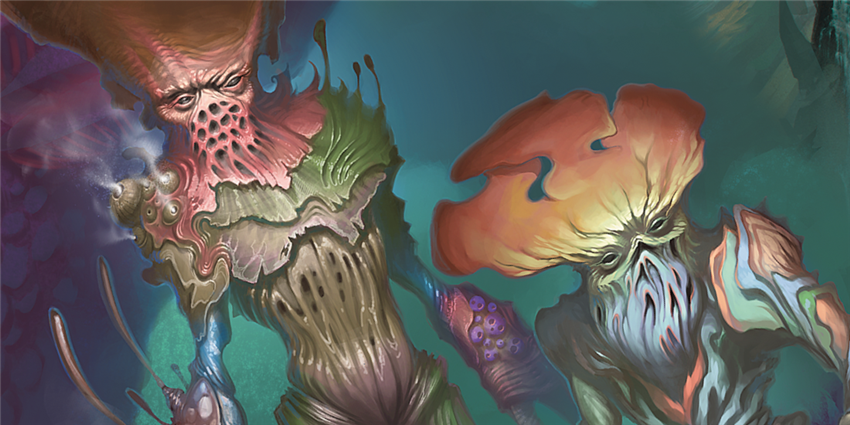
Combat Encounter: Mystery of the Myconid Mausoleum
This combat encounter is suited for parties of 3rd-level characters, and can be used as a follow-up to Encounter of the Week: Coral Colosseum.
Several days ago, a colony of myconids were born from the gloom and rot of a swamp near a small fishing town. They found a place to form their new colony, and settled on a crumbling mausoleum in a long-forgotten graveyard. Their rapport spores have been spreading unchecked, and have begun to infect the dead buried underneath the marsh. These dead have risen as spore servants, which the myconids are using as watchdogs to protect their new home from unwelcome intruders—like the adventurers.
Encounter Summary
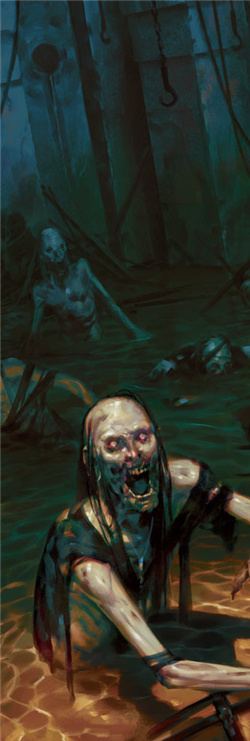 In this encounter, the characters stumble upon an old country graveyard in the middle of a swamp. When they investigate, they fall under attack by the living dead! Once they fend off their undead assailants, an investigation of the mausoleum reveals the true villain behind the attack: a group of mycanoids that infested the corpses with their spores, turning them into telepathically controlled puppets. From here, the characters can either negotiate with the mycanoids or kill them.
In this encounter, the characters stumble upon an old country graveyard in the middle of a swamp. When they investigate, they fall under attack by the living dead! Once they fend off their undead assailants, an investigation of the mausoleum reveals the true villain behind the attack: a group of mycanoids that infested the corpses with their spores, turning them into telepathically controlled puppets. From here, the characters can either negotiate with the mycanoids or kill them.
This encounter’s three acts are:
- The Discovery: the characters find an abandoned graveyard.
- The Trial: the characters are attacked by undead.
- The Revelation: the characters learn that the zombies are really mycanoid spore servants, and can try to reason with the mushroom-people or destroy them. Either way, there’s treasure!
Encounter Start (The Discovery)
While the characters are wandering through a darkened marsh, read or paraphrase the following:
While trudging through the marsh, the odious smell of marsh gas mingles with something else—like the scent of rotting flesh. Nearby, through the overgrowth, you see a small graveyard. About two dozen ancient tombstones rise out of the swampy soil, and a stone mausoleum looms over the headstones.
If the characters decide to avoid the graveyard, let them. There may be consequences when the marsh becomes absolutely overrun by mycanoid spore servants over the next week or so.
Zombie Attack (The Trials)
If the characters investigate, read or paraphrase the following:
The graveyard seems to have been abandoned for a long time. The headstones have been worn smooth, and most are covered by moss, swamp grime, and copious amounts of fungi. The mausoleum looms over everything, and a faint cloud of mist emanates from its darkened threshold.
Before the characters can reach the mausoleum, however, a rotten hand bursts from the soggy soil. Followed by another, and another! Three rotting humans with horrifically long nails and corroded chain mail dredge themselves out of the ground and hiss at the characters. Roll initiative! These three spore-infested corpses appear to be zombies, but are actually revived by myconid rapport spores; use quaggoth spore servant statistics for these creatures.
These spore servants fight to the death.
Myconid Mausoleum (The Reveal)
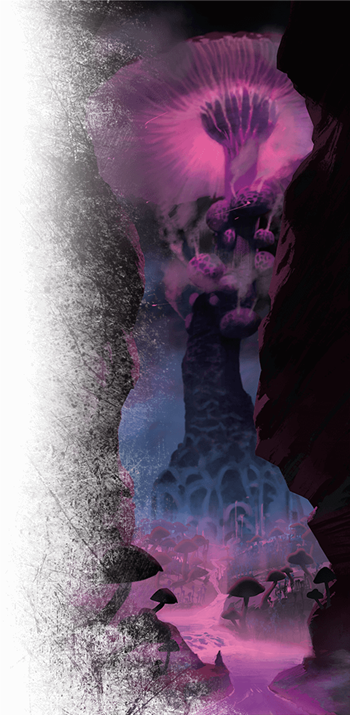 The “mist” billowing from the entrance to the mausoleum isn’t mist at all. Characters that succeed on a DC 16 Wisdom (Perception) check realize that it’s actually a cloud of incredibly fine fungal spores. Any character that walks through the spores and into the mausoleum must succeed on a DC 8 Constitution saving throw or start coughing uncontrollably, spoiling the element of surprise. If a character lingers here for another hour, they must make another saving throw. If a character fails three of these saving throws over the course of 24 hours, they are infected by myconid spores and become a spore servant.
The “mist” billowing from the entrance to the mausoleum isn’t mist at all. Characters that succeed on a DC 16 Wisdom (Perception) check realize that it’s actually a cloud of incredibly fine fungal spores. Any character that walks through the spores and into the mausoleum must succeed on a DC 8 Constitution saving throw or start coughing uncontrollably, spoiling the element of surprise. If a character lingers here for another hour, they must make another saving throw. If a character fails three of these saving throws over the course of 24 hours, they are infected by myconid spores and become a spore servant.
The inside of the mausoleum is pitch black. Inside are ten myconid sprouts (noncombatants), four myconid adults, and one myconid sovereign, which has grown up around a statue of Kord, god of storms, who watches over the dead.
These myconids react in horror as the characters enter, and assume a defensive stance. If the characters try to communicate with them, they happily parley using their rapport spores. The myconids just want to be left alone, but also want to spread their colony throughout the marsh. A character that presents a reasonable plan for the myconids and the nearby town to live in peace can make a DC 14 Charisma (Persuasion) check. On a success, the myconids agree to this plan, and keep their word for the rest of the current sovereign’s life, which is about 24 years.
Conclusion
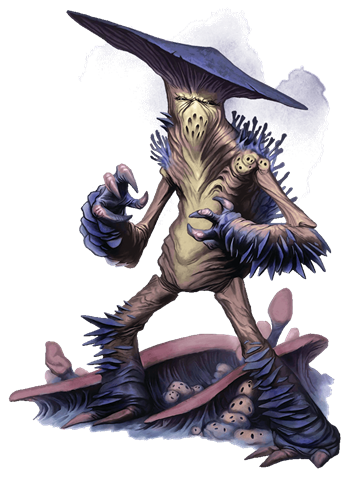 If the characters successfully parley with the myconids, the sovereign hands over a +1 rod of the pact keeper as a symbol of their agreement. If the characters kill the myconids, they find the rod gripped in the hand of the statue of Kord looking over the mausoleum.
If the characters successfully parley with the myconids, the sovereign hands over a +1 rod of the pact keeper as a symbol of their agreement. If the characters kill the myconids, they find the rod gripped in the hand of the statue of Kord looking over the mausoleum.
If you include this encounter as part of a larger campaign, try to give the characters’ choice of whether to spare or kill the mycanoids some meaning later in your campaign. What positive interactions can the characters have with the mycanoids later in the campaign if they were spared? Perhaps one of the young myconids leaves home and begins training as an adventurer, and the characters meet this new myconid hero in a town somewhere. Perhaps as a Circle of Spores druid?
What consequences can the characters experience as a result of their deaths? Maybe there were dozens more spore servants hidden in the swamp that have gone berserk as the result of their sovereign’s death.
Did you like this encounter? If you want to read more adventures, take a look at the other encounters in the Encounter of the Week series! If you're looking for full adventures instead of short encounters, you can pick up the adventures I've written on the DMs Guild, such as The Temple of Shattered Minds, a suspenseful eldritch mystery with a mind flayer villain (for 3rd level characters). My most recent adventures are included in the Gold Best Seller Tactical Maps: Adventure Atlas, a collection of 88 unique encounters created by the Guild Adepts, which can be paired with the beautiful tactical poster maps in Tactical Maps Reincarnated, recently published by Wizards of the Coast.
 James Haeck is the lead writer for D&D Beyond, the co-author of Waterdeep: Dragon Heist and the Critical Role Tal'Dorei Campaign Setting, the DM of Worlds Apart, and a freelance writer for Wizards of the Coast, the D&D Adventurers League, and Kobold Press. He lives in Seattle, Washington with his partner Hannah and their feline adventurers Mei and Marzipan. You can usually find him wasting time on Twitter at @jamesjhaeck.
James Haeck is the lead writer for D&D Beyond, the co-author of Waterdeep: Dragon Heist and the Critical Role Tal'Dorei Campaign Setting, the DM of Worlds Apart, and a freelance writer for Wizards of the Coast, the D&D Adventurers League, and Kobold Press. He lives in Seattle, Washington with his partner Hannah and their feline adventurers Mei and Marzipan. You can usually find him wasting time on Twitter at @jamesjhaeck.








-
View User Profile
-
Send Message
Posted May 15, 2019You're a blessing man
-
View User Profile
-
Send Message
Posted May 15, 2019rod of pact keeper... I've never had a party with a warlock.
-
View User Profile
-
Send Message
Posted May 15, 2019Next week is the last week of school for me. You should write an encounter that revolves around school. Just a suggestion. 😁
-
View User Profile
-
Send Message
Posted May 15, 2019As I play a Circle of the Spores druid myconid myself in our campaign, I do appreciate the little suggestion at the end!
-
View User Profile
-
Send Message
Posted May 17, 2019Who wants to hear more about school? Thank goodness it’s over for me.
-
View User Profile
-
Send Message
Posted May 17, 2019My Group mates PM'd me this and honestly? I actually find this interesting, might use this in the future. also that little tid bit at the end about the spore druid was great. Reason being? I actually play a homebrew myconid in my current campaign who is actually a circle of the spores druid! Glad to see our fellow mushrooms are doing well.
-
View User Profile
-
Send Message
Posted May 19, 2019+1. I can just put this at the end of my next session in case the players get through their current challenge too quickly.
-
View User Profile
-
Send Message
Posted May 23, 2019I don't want to quibble in terms of literary discussion, but the three -act structure isn't always a form that storytellers use to guide the creation of a story, but rather a way of parsing and codifying what makes something a story. In other words, it would be true even if we didn't have a name for it. Every complete story has a beginning, middle, and an end, and most of them have, as the climax of the beginning, an inciting event, rising action through the middle, a climactic event, and a denouement. Arguments abound about whether the last two things happen in the Act 2 climax or as the Act 3 intro.
Nonetheless, even the worst story has a beginning, a middle, and an end, and you could argue has three acts as a result. "The young one woke up." Is a terrible story, but it has a beginning - where the young one is asleep - a middle - where they wake - and an end, where they are now awake, marking the change in state from where the story began (asleep) to where it ends.
I only quibble because I find that understanding that this structure is the way by which humans interpret and process stories and arguably always has been has been super helpful as I approach DMing.
-
View User Profile
-
Send Message
Posted May 27, 2019I am a Myconid fanboy. I think there is something so unusual about them compared to all the other races that are just variants of some common myths.
-
View User Profile
-
Send Message
Posted Jun 3, 2019Splendid adjustment! That was what I was thinking with the rod of the pactkeeper, that it only suits warlocks so something else might better suit a different kind of party.
-
View User Profile
-
Send Message
Posted Jun 3, 2019I just ran this encounter last night, and as a novice DM it was super fun and intuitive! Thank you so much for Encounter of the Week; it's a wonderful resource.
-
View User Profile
-
Send Message
Posted Jun 8, 2019Can we add a circle of spores druid has advantage on persuasion
-
View User Profile
-
Send Message
Posted Dec 30, 2019Loved it.
Changed it a little, put a few of my own villains into this to fit into the overarching theme of my quest i'm DMing.
Thanks!
-
View User Profile
-
Send Message
Posted Sep 9, 2020Maybe the Magic The Gathering and D&D worlds exist together. Maybe someone can Planeswalk from Theros to Ebberon, for instance. It's possible.